
The cicadas are a superfamily, the Cicadoidea, of insects in the order Hemiptera. They are in the suborder Auchenorrhyncha, along with smaller jumping bugs such as leafhoppers and froghoppers. The superfamily is divided into two families, the Tettigarctidae, with two species in Australia, and the Cicadidae, with more than 3,000 species described from around the world; many species remain undescribed.
Semia is a genus of Asian cicadas in the tribe Cicadini, erected by Matsumura in 1917.

The term periodical cicada is commonly used to refer to any of the seven species of the genus Magicicada of eastern North America, the 13- and 17-year cicadas. They are called periodical because nearly all individuals in a local population are developmentally synchronized and emerge in the same year. Although they are sometimes called "locusts", this is a misnomer, as cicadas belong to the taxonomic order Hemiptera, suborder Auchenorrhyncha, while locusts are grasshoppers belonging to the order Orthoptera. Magicicada belongs to the cicada tribe Lamotialnini, a group of genera with representatives in Australia, Africa, and Asia, as well as the Americas.
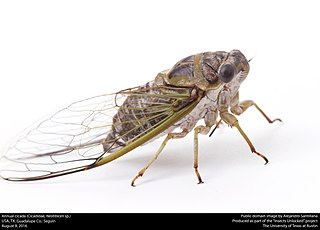
Cicadidae, the true cicadas, is one of two families of cicadas, containing almost all living cicada species with more than 3,200 species worldwide.

The yellow-crested cockatoo also known as the lesser sulphur-crested cockatoo, is a medium-sized cockatoo with white plumage, bluish-white bare orbital skin, grey feet, a black bill, and a retractile yellow or orange crest. The sexes are similar.

Cicadas of the genus Neotibicen are large-bodied insects of the family Cicadidae that appear in summer or early fall in eastern North America and formerly Bermuda. Common names include cicada, harvestfly, jar fly, and the misnomer locust.

Cicada killer wasps are large, solitary, ground-dwelling, predatory wasps. They are so named because they hunt cicadas and provision their nests with them, after stinging and paralyzing them. Twenty-one species worldwide are recognized. The highest diversity occurs in the region between North Africa and Central Asia.

The Tettigarctidae, known as the hairy cicadas, are a small relict family of primitive cicadas. Along with more than 20 extinct genera, Tettigarctidae contains a single extant genus, Tettigarcta, with two extant species, one from southern Australia and one from the island of Tasmania. Numerous fossil species have been described from the Late Triassic onwards. Tettigarcta are the closest living relatives of the true cicadas.

Gaeanini is a tribe of cicadas in the family Cicadidae, found in the Palearctic and Indomalaya. There are about 10 genera and at least 50 described species in Gaeanini.
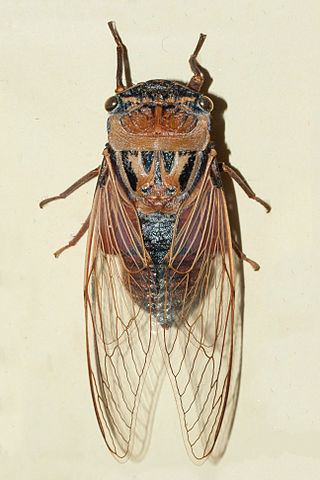
Thopha saccata, the double drummer, is the largest Australian species of cicada and reputedly the loudest insect in the world. Documented by the Danish zoologist Johan Christian Fabricius in 1803, it was the first described and named cicada native to Australia. Its common name comes from the large dark red-brown sac-like pockets that the adult male has on each side of its abdomen—the "double drums"—that are used to amplify the sound it produces.

Chelonistele is a genus of the orchid family consisting of 13 currently accepted species. It is native to Indonesia, Malaysia and the Philippines. The plant grows as an epiphytic or lithophytic orchid.
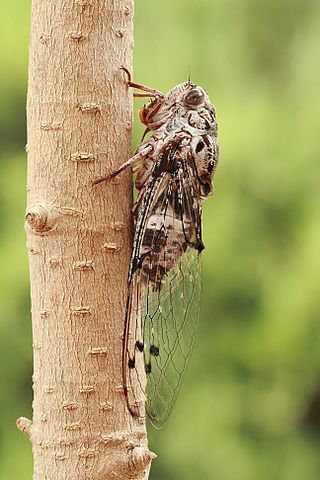
Aleeta curvicosta is a species of cicada, one of Australia's most familiar insects. Native to the continent's eastern coastline, it was described in 1834 by Ernst Friedrich Germar. The floury baker is the only described species in the genus Aleeta.

Psaltoda plaga is a species of cicada native to eastern Australia, from Maryborough in central Queensland to Bega in southern New South Wales. Adult cicadas appear over the summer and inhabit forested areas near bodies of water. The predominantly black form from the Sydney and Central Coast regions is commonly known as the black prince, while the term silver knight is used for the species as a whole.

Gaeana is a genus of cicadas, most members of which have colourful marking on their forewings, found across tropical and temperate Asia. Their bright wing patterns have been hypothesized as being a case of Batesian mimicry where the toxic models may be day-flying moths of the subfamilies Zygaeninae and Arctiinae. It is closely related to the genus Tosena but is differentiated by the exposed tympanum and lacks spines on the sides of the pronotum.
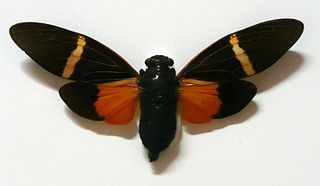
Tosena paviei is a cicada species from Southeast Asia. It has been recorded from Thailand and Vietnam. The type specimens(s) were collected on the 'Route de Luang-Prabang à Theng'. Luang Prabang is now in Laos but Theng probably refers to Điện Biên Phủ, a city in the Northwest region of Vietnam near the border with Laos which was formerly called Thaeng or Muong Thanh. So it's not clear if the type specimen(s) were collected in Laos or Vietnam.

Bulbaeolidia is a genus of marine nudibranch in the family Aeolidiidae.

Tibicen is a historical genus name in the insect family Cicadidae that was originally published by P. A. Latreille in 1825 and formally made available in a translation by A. A. Berthold in 1827. The name was placed on the Official Index of Rejected and Invalid Generic Names in Zoology by the International Commission on Zoological Nomenclature in 2021. Certain European cicada species that were included by some authors in this genus at the time of its suppression are now listed under genus Lyristes Horváth, 1926. Other formerly-Tibicen species are placed in the tribe Cryptotympanini and include the genera Auritibicen Lee, 2015, Hadoa Moulds, 2015 Megatibicen Sanborn and Heath, 2016, and Neotibicen Hill and Moulds, 2015.

Rhipiceridae is a family of beetles found worldwide. The larva of rhipicerids are parasitoids of cicada nymphs. Rhipiceridae and Dascillidae form the super family Dascilloidea, within the Elateriformia.
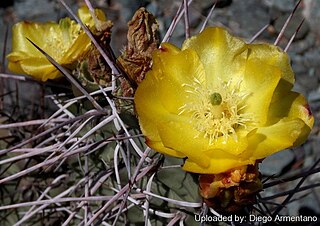
Opuntia sulpurea falls under the Opuntia, or prickly pear, genus within the family Cacataceae named such because of their round shape, green color, and long thick spines. Opuntia sulphurea is the widest spread of the Opuntia that can be found in and around Argentina, occupying mostly arid areas of the region from the plains in the Western portion of Argentina up to much higher altitudes on the Eastern side of the Andes mountain range. As a result of its ability to survive in such a diverse array of environments there are several subspecies of O. sulphurea that are identifiable based on the number of spine per areole, for example. A commonality across the three is a bright yellow flower, often considered to be the color of sulfur, from which the species name is derived. As with several other species of Opuntia, these prickly pears tend to grow in groups, forming clumps that can reach one to two meters in diameter, but while other species within the genus grow upwards as well O. sulphurea tend to stay low to the ground. As a result of its tendency to grow in dry, arid, and rocky areas this cactus has evolved to be very resilient, not even suffering from the effects of agriculture, i.e. cattle grazing, on lower altitude subpopulations.
Vespula sulphurea, the California yellowjacket, is a species of wasp within the family Vespidae. It is found distributed in the Upper Sonoran Fauna of California, but has been known to occur in southern Oregon, western Nevada, southern Arizona, and northern Baja California. Nests of the species are found underground, with a maximum known worker count of 1,100. It is preyed upon by the California scrub jay and spiders in the Peucetia genus. It feeds and polinates on plants such as fennel, California figwort, and the chaparral broom.

















